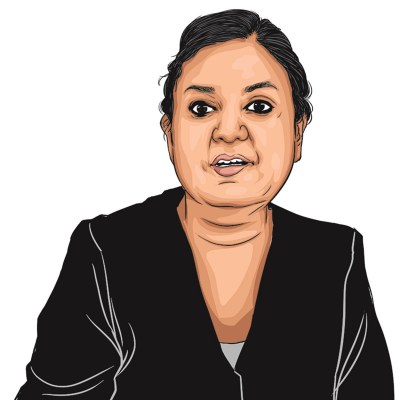Opinion If Salman Khan is still ‘Bhai’, why is Madhuri Dixit a ’90s woman superstar’?
Bollywood's women stars from previous decades continue to work, inspire and thrive. Yet, the sexist double standard in how we see them continues unabated
 Fact is, the idea of a woman superstar has never been tested or allowed to flourish enough in the mass market, which has, by now, been heavily drugged on formula. (Express/Instagram)
Fact is, the idea of a woman superstar has never been tested or allowed to flourish enough in the mass market, which has, by now, been heavily drugged on formula. (Express/Instagram) Back in 2015, Dame Helen Mirren, now a silver-haired 77-year-old, had best articulated the ageist bias with regard to women actors in Hollywood: “We all watched James Bond as he got more and more geriatric, and his girlfriends got younger and younger. It’s so annoying.” The legendary Meryl Streep, despite a clutch of Oscar trophies, actually funded a screenwriters’ workshop for women over 40 so that more stories could be written about real women finding their place in the real world that could then get made into films. Meanwhile, Penelope Cruz, who has been calling out ageism for years, tells journalists who ask her about her status as an ageing actor, “I’m not going to give you even two minutes to honour your question. It doesn’t deserve that.”
All three are powerful women in Hollywood, speaking from a position of acquired strength and wisdom, trying to change the gendered discourse on their terms. Backed by a body of award-winning work that has brought big bucks and value to the big studios that hired them, they earned their podium rights.
Raveena Tandon is nowhere near them but is no less qualified to talk about ageist biases in Bollywood. She asked why her peer Madhuri Dixit should be pigeonholed as a “female superstar of the 90s” when their male peers are considered ageless. She should know this best. Having begun her career with actor Salman Khan in Patthar Ke Phool (1991) and delivered the cult hit Andaz Apna Apna (1994) with him. They were the flower children of a just-liberalised India. Yet she wilted by the wayside while Khan at 57 continues to romance Pooja Hegde, 32, in 2022. And courtesy of the finesse of air-brushing technology and a few cosmetic makeovers, we never make out a difference. Salman at 57 in his Panvel farmhouse, hiding his frailties, will never be the digitally-mastered and larger-than-life Salman on screen. May we say, Tandon herself would look much better, with or without the cosmetic jugglery, if the two were cast together. But that would, as trade pundits would tell you, be harakiri for the producer in an industry that equates alpha maleness to financial muscle. Be it Aamir or Shah Rukh, the selling point of their ventures has been their investable worth as age-defying demigods. Consider the publicity propaganda of Aamir’s Three Idiots (“Oh, he looks like a college kid”) or even Shah Rukh’s Pathaan (“Oh look at those abs at 57”).
This is where the efforts of Vidya Balan or more recently, Alia Bhatt, who have shouldered the burden of being the protagonist and delivered Rs 100-crore revenues for their producers, come to nought. Unfortunately, their projects are still considered women-oriented and not mainstream films — a value-add than the value itself. A woke moment that allows Bollywood to pat itself on the back for being in sync with the times. In fact, the definition of mainstream films in India, be it Hindi or regional blockbusters, continues to be contoured by the idea of a Herculean male superstar. Even successful women filmmakers like Farah Khan sadly entrench the male stereotype to get the crowds going at Chandan cinema, her barometer for pan-India success. Zoya Akhtar, for all her attempts at slice-of-life realism on the big screen, is still considered effete. Fact is, the idea of a woman superstar has never been tested or allowed to flourish enough in the mass market, which has, by now, been heavily drugged on formula. In a country where Shakti peeths draw in the most pilgrims, that wouldn’t be impossible really.
Tandon, many critics believe, made her dough by catering to the male gaze through song sequences like Tu Cheez Bari Hai Mast Mast, and, therefore has no locus standi to talk about the rightful place of women in the film industry. In her time, even the likes of Madhuri Dixit weren’t really given the space to exercise their acting chops. Just map the cult Bollywood hit songs; chances are they would mostly feature more women than men. As for acting chops, Dixit and Karisma Kapoor did manage to get noticed in the latter half of their industry shelf life. Today, it is the so-called “90s women superstars” who have aced the OTT ratings, Tandon herself playing an investigative woman cop with Aranyak, Dixit as a justice-seeking ageing actress in The Fame Game and Sushmita Sen a revenge-seeking Aarya. Such has been their performance that studios themselves are offering them new seasons. Besides, they are all ambassadors for top-of-the-line brands, motivational speakers, show hosts and anchors, all of which are the ad world’s barometer for public acceptance. They all play to their strengths, unabashed about their age and wrinkles, and in their sequences definitely look fitter than Aamir Khan running as Lal Singh Chadha. This, after taking their breaks for marriage and maternity and owning their evolution as women.
Of course, the media itself, which is best placed to correct perceptions, is equally guilty. While branding the efforts of 40-plus women as a “comeback”, it fetes Aamir Khan for taking a “year’s creative break” for “family time” and his suddenly undyed hair. Will it question him about a “comeback” a year later or pardon him the vanity of colouring his hair? Or starring with a newbie and justify it as another “hatke” film? Won’t it be a too-90s thing to do?
rinku.ghosh@expressindia.com





